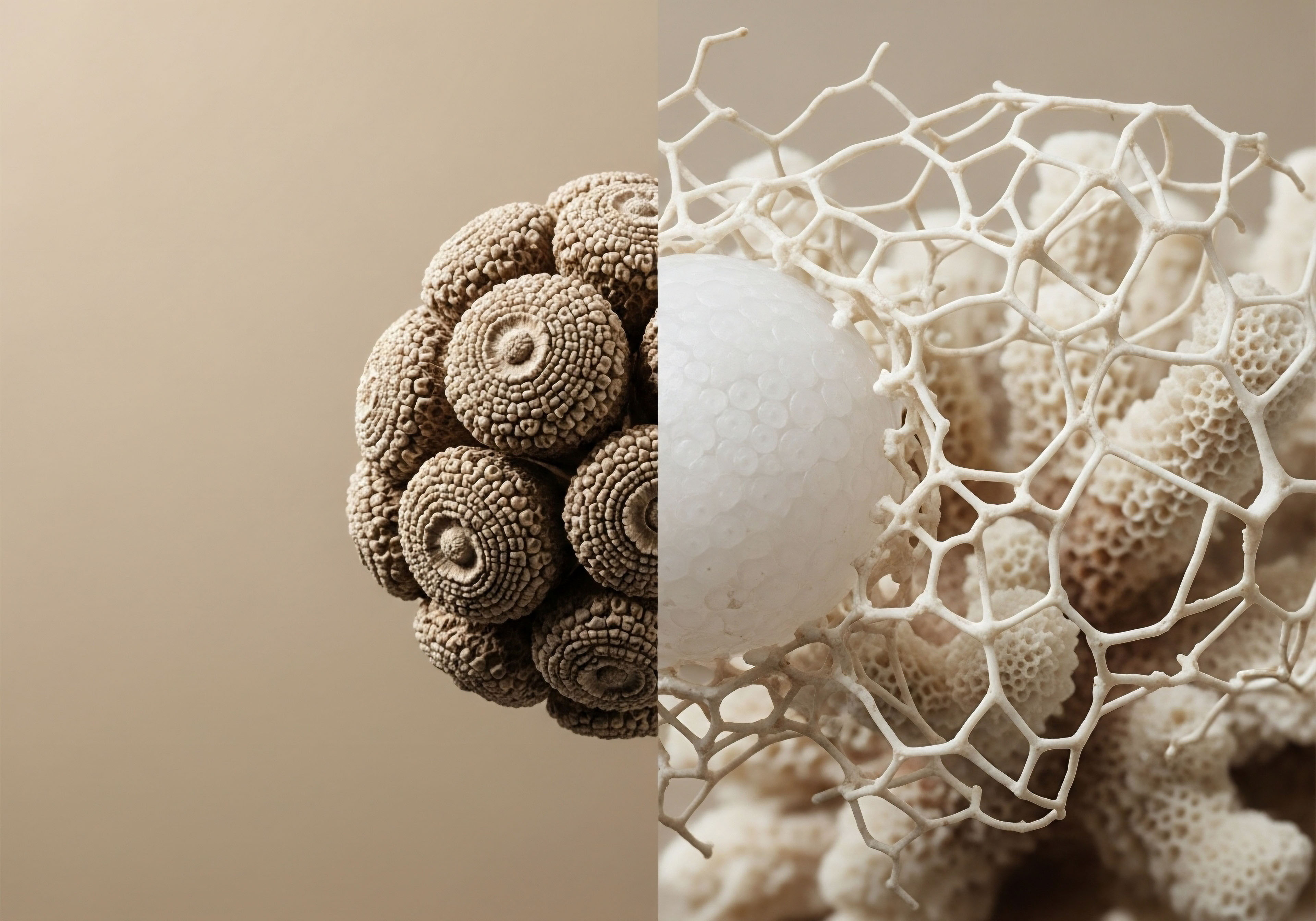

Fundamentals
You may have noticed a change in your blood pressure readings since beginning a hormonal optimization protocol, or perhaps this is a key concern as you consider starting one. It is a valid point of focus. The experience of seeing that number fluctuate can be unsettling, and it is important to understand the biological reasons for this.
Your body is a finely tuned system, and introducing therapeutic testosterone initiates a series of adjustments. The relationship between testosterone and the complex systems that regulate blood pressure is intricate, with the hormone capable of exerting multiple, sometimes opposing, influences simultaneously.
Feeling a sense of vitality return is the goal of endocrine system support. Simultaneously, maintaining cardiovascular health is paramount. The way your body manages blood pressure involves a constant dialogue between your kidneys, blood vessels, and nervous system. Testosterone enters this conversation and can change the dialogue in several ways.
One of the most direct effects is on the production of red blood cells. An increase in testosterone can signal the bone marrow to produce more of these cells, a condition known as erythrocytosis. A higher concentration of red blood cells increases the thickness, or viscosity, of the blood. Your heart must then work harder to pump this denser blood through your vessels, which can lead to an increase in pressure against the artery walls.
The viscosity of your blood, influenced by red blood cell count, is a primary factor in how testosterone therapy can affect blood pressure.

The Role of Fluid Balance
Another significant mechanism involves how your body manages salt and water. Testosterone can interact with the kidneys and influence the retention of sodium. Where sodium goes, water follows. This increased fluid retention expands the total volume of blood within your circulatory system.
Imagine a closed plumbing system; increasing the amount of fluid within the same set of pipes naturally increases the pressure inside. This is a key reason why monitoring fluid balance and sodium intake becomes particularly important when undergoing hormonal recalibration.

Vascular Tone and Communication
Your blood vessels are not rigid pipes. They are dynamic tissues that can constrict (tighten) or dilate (relax) to manage blood flow and pressure. Testosterone has a complex relationship with the cells lining your blood vessels, known as the endothelium.
In some circumstances, testosterone can promote the release of substances that cause blood vessels to relax, which would lower blood pressure. In other situations, particularly with long-term exposure or when testosterone is converted into other hormones like estrogen, it can contribute to processes that lead to less flexible, or even more constricted, vessels. The net effect is highly individual, depending on your unique physiology, the specific therapeutic protocol, and pre-existing health factors.
Understanding these foundational mechanisms provides a framework for interpreting your body’s response. It is a process of recalibration, where initial changes may level out as your system adapts. This biological adjustment period underscores the necessity of consistent monitoring and open communication with your clinical provider to ensure the protocol is tailored perfectly to your body’s needs, optimizing both vitality and cardiovascular safety.


Intermediate
Moving beyond the direct effects on blood volume and viscosity, we can examine the specific biochemical signaling systems that testosterone modulates. The body’s primary system for long-term blood pressure control is the Renin-Angiotensin-Aldosterone System (RAAS). Think of the RAAS as a sophisticated hormonal cascade that acts like a thermostat for blood pressure.
When the system senses a drop in pressure or blood flow to the kidneys, it initiates a series of steps to raise it. Evidence indicates that androgens, including testosterone, can stimulate key components of this system. Specifically, testosterone appears to increase the production of renin, an enzyme released by the kidneys, and angiotensin-converting enzyme (ACE). This stimulation pushes the RAAS toward a state that favors vasoconstriction and sodium retention, creating a biological predisposition for higher blood pressure.

How Does the RAAS Influence Blood Pressure?
The RAAS operates through a sequence of hormonal activations. Increased renin leads to higher levels of Angiotensin II, a potent vasoconstrictor that narrows blood vessels throughout the body. Angiotensin II also signals the adrenal glands to release aldosterone, a hormone that instructs the kidneys to retain more sodium and water, thereby increasing blood volume.
By amplifying parts of this cascade, testosterone therapy can effectively turn up the setting on this internal thermostat, leading to a sustained increase in baseline blood pressure in susceptible individuals. This is a critical reason why medications that block this system, such as ACE inhibitors or Angiotensin II Receptor Blockers (ARBs), are common treatments for hypertension.
Testosterone’s interaction with the Renin-Angiotensin-Aldosterone System (RAAS) can shift the body’s natural blood pressure regulation toward a higher set point.

The Paradoxical Role of Nitric Oxide
While the RAAS represents a pressure-increasing pathway, testosterone also interacts with a primary pressure-reducing pathway ∞ the production of nitric oxide (NO). Nitric oxide is a powerful vasodilator produced by the endothelial cells lining the blood vessels. It signals the smooth muscle of the arteries to relax, increasing their diameter and lowering blood pressure.
Some research shows that physiological levels of testosterone can activate the enzyme responsible for producing NO, known as endothelial nitric oxide synthase (eNOS). This action would theoretically protect cardiovascular health and lower blood pressure. This explains why men with clinically low testosterone sometimes exhibit poor endothelial function, and why restoring testosterone to a healthy level can, in some cases, improve it.
The effect, however, appears to be highly dependent on dosage and individual factors. Supraphysiological levels of testosterone, or rapid fluctuations seen with certain injection schedules, may not produce the same benefit and could even impair eNOS function. This duality highlights the importance of carefully managed therapy aimed at restoring a stable, optimal hormonal environment.

Comparing Protocol Components and Their Potential Impact
The specific medications included in a hormonal optimization protocol can also influence these pathways. For example, Anastrozole is used to control the conversion of testosterone to estrogen. Estrogen itself has complex effects on blood pressure, including a role in fluid retention. Managing estrogen levels is therefore an indirect method of managing a potential contributor to blood pressure changes.
| Protocol Component | Primary Function | Potential Influence on Blood Pressure Regulation |
|---|---|---|
| Testosterone Cypionate | Hormone replacement |
Can increase hematocrit and activate the RAAS. May also support nitric oxide production in a dose-dependent manner. |
| Anastrozole | Aromatase inhibitor (blocks estrogen conversion) |
Reduces estrogen-related fluid retention, which can be a factor in blood pressure elevation. |
| Gonadorelin | Maintains natural testicular function |
Has minimal direct impact on blood pressure regulation systems but supports overall HPG axis stability. |

What Are the Clinical Monitoring Guidelines?
Given these complex interactions, clinical guidelines emphasize vigilant monitoring. A baseline blood pressure reading is essential before initiating therapy. Subsequent checks should be performed regularly, especially during the initial months as your body adjusts. This systematic approach allows for the early detection of any upward trend, enabling timely adjustments to the therapeutic protocol or the implementation of lifestyle modifications to maintain cardiovascular safety.
- Baseline Measurement ∞ Establish a clear starting point before the first administration.
- Initial Phase Monitoring ∞ Check blood pressure at regular intervals (e.g. every 4-6 weeks) for the first six months.
- Stable Phase Monitoring ∞ Once on a stable dose with stable levels, monitoring can be part of routine semi-annual or annual assessments.
- At-Home Monitoring ∞ Using an automated cuff at home can provide a more accurate picture of your average blood pressure, free from the “white coat” effect of a clinical setting.


Academic
A sophisticated analysis of testosterone’s influence on blood pressure requires a systems-biology perspective, focusing on the modulation of competing homeostatic mechanisms at the molecular level. The prevailing evidence suggests testosterone does not act as a primary hypertensive agent but rather as a modulator that can shift the equilibrium of vascular control systems.
Its role can be described as “permissive” in the context of hypertension, particularly by amplifying the effects of the Renin-Angiotensin-Aldosterone System (RAAS). In animal models, castration can abolish the hypertensive response to Angiotensin II infusion, while testosterone replacement restores it, demonstrating that the presence of androgens is a requisite for the full expression of RAAS-mediated hypertension.

Shifting the Balance of the RAAS
The RAAS is not a monolithic entity. It contains a classical, pressor arm (ACE -> Angiotensin II -> AT1 receptor) and a counter-regulatory, depressor arm (ACE2 -> Angiotensin (1-7) -> Mas receptor). Testosterone appears to preferentially upregulate components of the classical arm. It increases renin substrate (angiotensinogen) from the liver and angiotensin-converting enzyme (ACE) activity, leading to a greater production of Angiotensin II.
Concurrently, it can downregulate the expression of the AT2 receptor, which mediates vasodilation and anti-proliferative effects. This coordinated shift creates a biochemical environment that favors vasoconstriction, sodium and water reabsorption via aldosterone, and vascular remodeling, all of which contribute to a higher blood pressure set point.

Genomic versus Non-Genomic Vascular Effects
The temporal nature of testosterone’s vascular effects reveals another layer of complexity. The hormone can elicit both rapid, non-genomic responses and slower, genomic responses.
- Non-Genomic Pathway ∞ Acute administration of testosterone can induce vasodilation within minutes. This is believed to occur through mechanisms independent of gene transcription, such as the modulation of ion channels in vascular smooth muscle cells or the rapid activation of endothelial nitric oxide synthase (eNOS) through a non-nuclear androgen receptor. One identified pathway involves the androgen receptor interacting directly with the p85alpha subunit of PI3-kinase, initiating a signaling cascade that phosphorylates and activates Akt, which in turn phosphorylates and activates eNOS. This leads to a burst of nitric oxide production and subsequent vasorelaxation.
- Genomic Pathway ∞ Long-term exposure to androgens engages classical nuclear receptor signaling. This involves testosterone binding to the androgen receptor, which then translocates to the nucleus and acts as a transcription factor. These genomic effects can be pro-hypertensive. Over time, testosterone can upregulate the expression of vasoconstrictive agents like thromboxane A2 and endothelin-1, while also promoting the cellular changes associated with vascular remodeling and atherosclerosis.
This dichotomy explains some of the conflicting results in the literature. Short-term studies or those examining acute effects might observe a neutral or even beneficial impact on vascular tone, while long-term observational data may associate high androgen states with increased cardiovascular risk, especially when other risk factors are present.
The long-term genomic actions of testosterone on gene expression can favor vasoconstriction, contrasting with its rapid, non-genomic effects that may promote vasodilation.

What Is the Impact on Endothelial Progenitor Cells?
Beyond direct vascular effects, testosterone influences the body’s capacity for endothelial repair. The endothelium is not static and requires constant maintenance, which is performed in part by endothelial progenitor cells (EPCs) circulating in the blood. These cells can be recruited to sites of vascular injury to replace damaged endothelial cells.
Testosterone deficiency is associated with a reduction in the number and functional capacity of EPCs. Restoring testosterone to physiological levels appears to improve EPC function, which is a crucial mechanism for maintaining long-term vascular health. This suggests that while TRT might present challenges to blood pressure regulation via the RAAS and hematocrit, it may also provide a benefit by enhancing the vascular repair system. The net clinical outcome for an individual depends on the balance of these competing effects.
| Mechanism | Molecular Action | Net Effect on Blood Pressure |
|---|---|---|
| RAAS Modulation |
Upregulates renin, ACE, and AT1 receptor expression; may downregulate AT2 receptor expression. |
Increase |
| Erythropoiesis |
Stimulates erythropoietin production, leading to increased red blood cell mass (hematocrit). |
Increase |
| eNOS Activation (Non-Genomic) |
Activates PI3K/Akt pathway, leading to rapid phosphorylation of eNOS and NO production. |
Decrease |
| Vascular Gene Expression (Genomic) |
Increases transcription of pro-constrictive factors like thromboxane A2 and endothelin-1. |
Increase |
| Endothelial Repair |
Improves number and function of endothelial progenitor cells (EPCs). |
Indirect Decrease / Protective |

References
- Seikaly, M G. “Gender and the renin-angiotensin-aldosterone system.” Fundamental & Clinical Pharmacology, vol. 24, no. 6, 2010, pp. 687-98.
- Danser, A H Jan, et al. “Hypertension ∞ Renin-Angiotensin-Aldosterone System Alterations.” Hypertension, vol. 65, no. 3, 2015, pp. 25-37.
- Reckelhoff, Jane F. “Testosterone and Blood Pressure Regulation.” Current Opinion in Nephrology and Hypertension, vol. 17, no. 2, 2008, pp. 180-4.
- El-Mas, Mahmoud M. and Abdel A. Abdel-Rahman. “Testosterone plays a permissive role in angiotensin II-induced hypertension and cardiac hypertrophy in male rats.” Biology of Sex Differences, vol. 2, no. 1, 2011, p. 8.
- Sullivan, Jennifer C. et al. “Sex differences in the renin-angiotensin-aldosterone system and its roles in hypertension, cardiovascular, and kidney diseases.” Frontiers in Endocrinology, vol. 14, 2023, p. 1245668.
- Yu, Jing, et al. “Androgen receptor-dependent activation of endothelial nitric oxide synthase in vascular endothelial cells ∞ role of phosphatidylinositol 3-kinase/akt pathway.” Molecular Endocrinology, vol. 24, no. 10, 2010, pp. 1954-65.
- Hotta, Yasushi, et al. “Testosterone Deficiency and Endothelial Dysfunction ∞ Nitric Oxide, Asymmetric Dimethylarginine, and Endothelial Progenitor Cells.” Sexual Medicine Reviews, vol. 7, no. 4, 2019, pp. 661-8.
- Reckelhoff, Jane F. and Yumei Ouyang. “Testosterone and Blood Pressure Regulation.” Hypertension, vol. 47, no. 5, 2006, pp. 826-7.
- Svartberg, Johan. “Testosterone plays a permissive role in angiotensin II-induced hypertension and cardiac hypertrophy in male rats.” Journal of Hypertension, vol. 29, no. 8, 2011, pp. 1497-8.
- Aversa, Antonio, et al. “Effect of High Testosterone Levels on Endothelial Function in Aorta and Erectile Function in Rats.” Sexual Medicine, vol. 7, no. 4, 2019, pp. 469-77.
- “TRT and Blood Pressure ∞ What You Need to Know About Managing Hypertension.” Regenx Health, 23 Aug. 2024.
- “The Importance of Monitoring Blood Pressure While on Testosterone Therapy.” Defy Medical, 4 Aug. 2023.
- “TRT & Blood Pressure.” The Men’s Health Clinic, 1 Mar. 2018.

Reflection
The information presented here provides a map of the biological territory where hormones and cardiovascular function intersect. This map is not the journey itself. Your personal health path is unique, shaped by your genetics, lifestyle, and the specific nuances of your physiology.
The purpose of this knowledge is to transform abstract data points on a lab report or a blood pressure reading into a coherent understanding of your own body’s systems. It allows you to move from a passive role to an active, informed participant in your wellness protocol.
Consider how these systems might be operating within you. Reflect on how this deeper awareness changes the conversation you have with yourself, and with your clinical team, about your health goals and the precise path required to achieve them.



